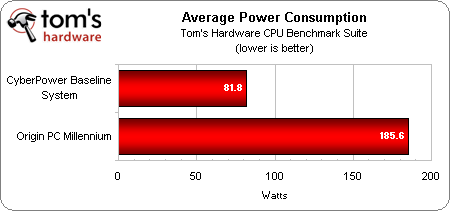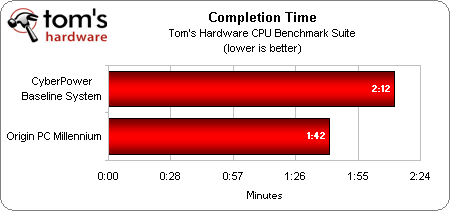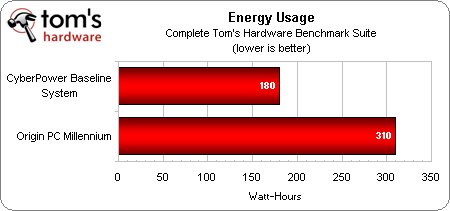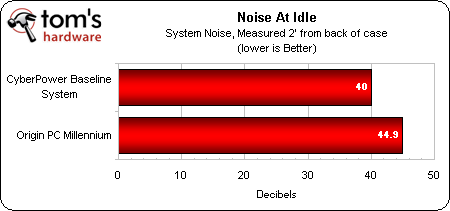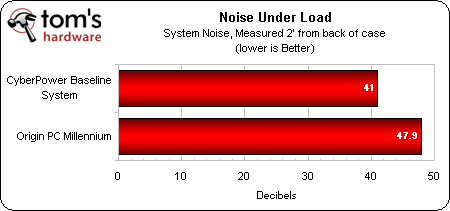Origin PC Millennium: 3-Way SLI And A 4.6 GHz Core i5
After a long hiatus, Tom's Hardware returns to consumer desktop reviews with Origin PC's Millennium. Can three GeForce GTX 660 Ti cards and an overclocked Core i5 handle gaming at 5760x1080? We want to know if this elegant box is worth its $3,000+ price.
Benchmark Results: Power Usage And Noise
Power consumption and acoustics are the two areas where the smaller, cheaper CyberPower baseline system looks better than the overclocked, triple-card Origin Millennium. While the Origin system is certainly faster in our CPU benchmark suite, it uses about 100 W more, on average, than the CyberPower system.
When we disregard the time it takes to complete our benchmarks, but instead look solely at energy consumption, the CyberPower baseline system consumes less than 60 percent of the power that the Millennium uses. However, the Origin system finishes the suite a full 30 minutes sooner. So, if time is money and your machine is constantly cranking through calculations, the extra speed is definitely worthwhile.
Our sound measurements also come out in favor of the CyberPower system. Despite being small, it’s very quiet, barely tipping our Pyle sound level meter above the ambient noise baseline, even under load. The Origin Millennium is reasonably quiet as well, especially considering its heavily overclocked CPU and trio of graphics cards. Neither system should be all that noticeable when gaming, unless you like playing stealth games at low volume in a quiet room.
Get Tom's Hardware's best news and in-depth reviews, straight to your inbox.
Current page: Benchmark Results: Power Usage And Noise
Prev Page Benchmark Results: Gaming Next Page Benchmark Results: Drive SpeedAfter a rough start with the Mattel Aquarius as a child, Matt built his first PC in the late 1990s and ventured into mild PC modding in the early 2000s. He’s spent the last 15 years covering emerging technology for Smithsonian, Popular Science, and Consumer Reports, while testing components and PCs for Computer Shopper, PCMag and Digital Trends.
-
DarkSable So... no mention of the fact that you're paying for a lot of things you don't need? In it's head-to-head against the DIY rig, I'm noticing a LOT of parts that I wouldn't even consider spending extra money on.Reply
And they're getting those parts at a discount, so you're paying a lot of money for that tech line. -
EzioAs "This system’s starting price is a relatively modest $1,225. For that, you get a Core i3-2120 CPU, an AMD Radeon HD 7750 graphics card, and a 500 GB hard drive."Reply
Wow, talk about rip off... -
DarkSable Reply9539987 said:"This system’s starting price is a relatively modest $1,225. For that, you get a Core i3-2120 CPU, an AMD Radeon HD 7750 graphics card, and a 500 GB hard drive."
Wow, talk about rip off...
Haha, yeah. That's about what I spent for an i5-3570k and GTX 670. I'll stick with my hand-builts and NOT pay $700 for a tech support who reads from a script. -
mayankleoboy1 For this much price, i would add another $100 and get the i7-3770k. Those extra 4 cores will come in handy in apps.Reply
And probably get 2xHD7950. 2 card setups are easier to maintain than 3 card setups (drivers). And the compute capability of GCN is already legendry. -
Caspase mayankleoboy1For this much price, i would add another $100 and get the i7-3770k. Those extra 4 cores will come in handy in apps.And probably get 2xHD7950. 2 card setups are easier to maintain than 3 card setups (drivers). And the compute capability of GCN is already legendry.Reply
Those extra 4 threads. And I bet at stock it would lose.
Why aren't temperatures shown? I was curious to see how an ivy @ 4.6 in a mid tower with 3 GPUs with modest cooling would fair...
